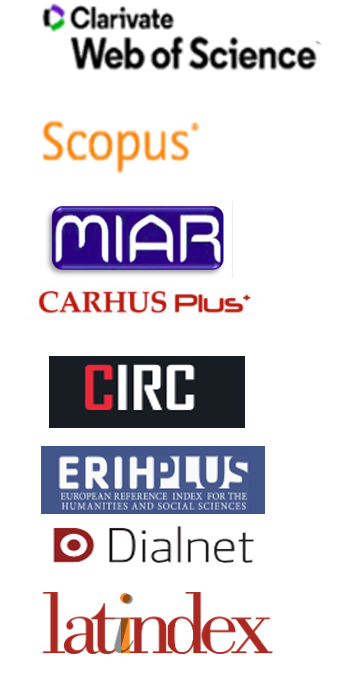The 3D register as a means for the analysis and dissemination of the sculptural heritage. The case of the wax sculpture of the Ecorché
Abstract
The application of 3D registration technologies in the field of the Conservation and Restoration of Cultural Heritage is a tool and a procedure of great potential that, today, is essential for the documentation and planning of an intervention; especially if it is sculptural-ornamental material. In the last decade, these technologies have experienced strong and rapid grows, which led to the appearance of a multitude of precise tools with different properties of manageability and level of resolution in the market. This work shows the 3D registration procedure carried out on a copy of the Houdon Écorché, a real sculpture made of wax, which is exposed in the hall of the Faculty of Fine Arts of the Polytechnic University of Valencia. For the registration process a high-performance white light portable laser scanner, model GoScan3D from Creaform Company, has been used. Likewise, the different factors involved in the registration of the work and derived from the technology used itself with respect to the characteristics of the piece have been analysed (such as size, composition, brightness, state of conservation, triangulation, resolution, reverberation of the surface of the work in contact with the light of the scanner, absorption of dark colours and positioning in relation to the surface of the work). Similarly, the collected data using the VXelements software have been interpreted and subsequently optimized. The results show the versatility of the tool and the quality of the 3d registration, improving the analysis processes and the diffusion of the artwork in virtual and interactive media.
Downloads
References
DÍAZ GÓMEZ, F. et al. (2015). “Modelado 3D para la generación de patrimonio virtual”. Virtual Archaeology Review, v. 6, n. 12, p. 29-37, ISSN 1989-9947. [consulta: 11/10/2017]
DÍAZ-MARÍN, C., AURA-CASTRO, E., SÁNCHEZ-BELENGUER, C., et al. (2016). “Cyclododecane as opacifier for digitalization of archaeological glass”. Journal of Cultural Heritage, 17, http://www.sciencedirect.com/science/article/pii/S1296207415001132 [consulta: 11/10/2017]
GRACIANO, A. et al. (2017). “Digitization of religious artifacts with a structured light scanner”. Virtual Archaeology Review, v. 8, n. 17, ISSN 1989-9947. https://polipapers.upv.es/index.php/var/article/view/4650 [consulta: 11/10/2017]
MADRID, J. (2012). “Aplicación de la técnica radiográfica digital en el estudio de Bienes Culturales. Caso de estudio de un desollado”. Revista Asociación Española de Ensayos No Destructivos. 61. ISSN 1888-9166 http://jmadrid.webs.upv.es/Files/Revista%20AEND%2061%20-%20Arte%20y%20Patrimonio.pdf [consulta: 11/10/2017]
MAS BARBERÀ, X. (2011). Métodos de sutitución: La réplica escultórica: Procedimientos de sustitución como intervención de conservación preventiva. Editorial de la UPV, Valencia, Ref. 2011.513
PORTILLO AMAVISCA, N., MOLINA, L., TRUJILLO, G. (2011). Escáner láser de objetos tridimensionales: conceptos y diseño. Alemania : Editorial Académica Española. ISBN 9783846576335
ROBLES ORTEGA, M. D., ORTEGA ALVARADO, L., FEITO HIGUERUELA, F. R. (2017). “Advances in 3D Spatial Information Systems. Applications in cultural heritage and virtual archeology”. Virtual Archaeology Review, v. 6, n. 12, ISSN 1989-9947. https://polipapers.upv.es/index.php/var/article/view/4161 [consulta: 11/10/2017]
RUIZ TORRES, D. (2017). El uso de tecnologías digitales en la conservación, análisis y difusión del patrimonio cultural. Acción Cultural Española (AC/E). ISBN: 978-84-15272-87-8
SCOTT-SPENCER, M. (2017), Introducction to Zbruzh 4R8. 2º ed, EEUU, The Gnomon Workshop, https://www.thegnomonworkshop.com/tutorials/introduction-to-zbrush-4r8 [consulta: 11/10/2017]
Webgrafía
AUTODESK. Autodesk Maya y Autodesk 3DsMax. https://www.autodesk.es/products [consulta: 11/10/2017]
BLENDER. Blender https://www.blender.org/ [consulta: 11/10/2017]
CHAOSGROUP. Vray. https://www.chaosgroup.com/ [consulta: 11/10/2017]
CREAFORM. https://www.creaform3d.com/es [consulta: 11/10/2017]
FORMLABS. Impresora SLA Form2 y software Preform. https://formlabs.com/ [consulta: 11/10/2017]
I.MATERIALISE. Servicios de impresión 3D. https://i.materialise.com/ [consulta: 11/10/2017]
IMPRIMALIA. Comparador de impresoras 3d. http://imprimalia3d.com/impresoras3d [consulta: 11/10/2017]
MAXON. Cinema 4D. https://www.maxon.net/es/ [consulta: 11/10/2017]
NEXT LIMIT. Maxwell. http://www.nextlimit.com/maxwell/ [consulta: 11/10/2017]
NVIDIA. Mental Ray e Iray http://www.nvidia.es/object/advanced-rendering-es.html [consulta: 11/10/2017]
OTOY. Octane Render. https://home.otoy.com/render/octane-render/ [consulta: 11/10/2017]
PIXAR. Render Man. https://renderman.pixar.com [consulta: 11/10/2017]
PIXOLOGIC. Zbrush. http://pixologic.com/ [consulta: 11/10/2017]
SCULPTEO. Servicios de impresión 3D y corte láser. https://www.sculpteo.com/es/ [consulta: 11/10/2017]
SKETCHFAB. Plataforma de visulaización 3D https://sketchfab.com/models/popular [consulta: 11/10/2017]
- Copyright and intellectual property belongs to author. Author guarantees editing and publishing rights to Ge-Conservación Journal, under a Creative Commons Attribution License. This license allows others to share the work with authorship and the original source of publication acknowledgement.
- Articles can be used for scientific and educational purposes but never for commercial use, being sanctioned by law.
- The whole content of the article is author’s responsibility.
- Ge-Conservación Journal and authors may establish additional agreements for non-exclusive distribution of the work version published at the Journal (for example, on institutional repositories or on a book) with acknowledgment of the original publication on this Journal.
- Author is allowed and encouraged to disseminate his works electronically (for example, on institutional repositories or on its own website) after being published on Ge-Conservación Journal. This will contribute for fruitful interchanges as also for wider and earlier citations of the author’s works.
- Author’s personal data will only be used for the Journal purposes and will not be given to others.









